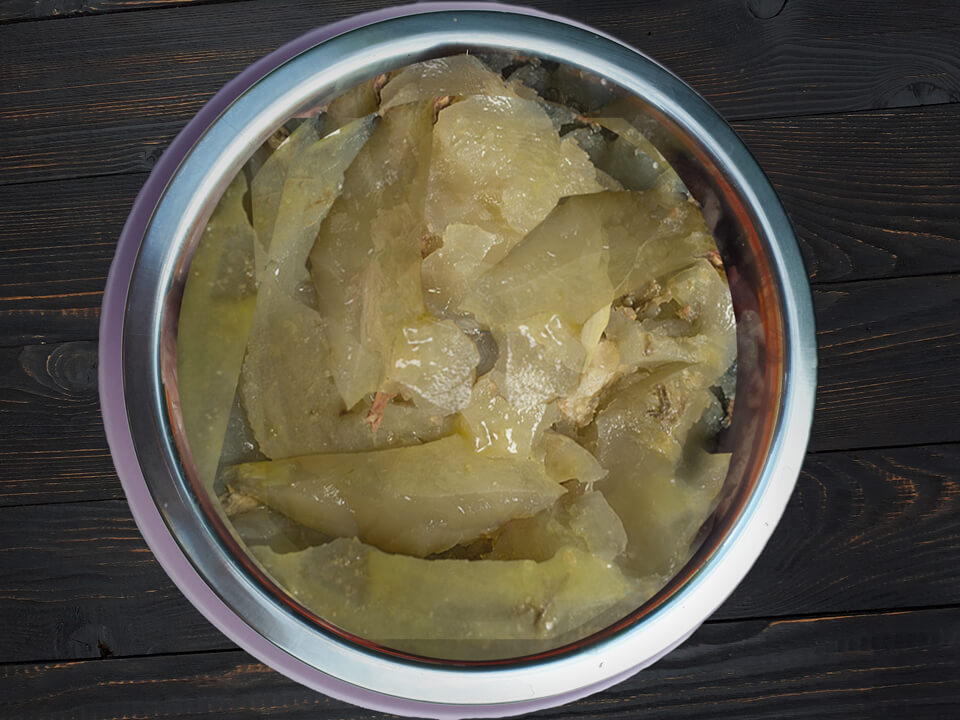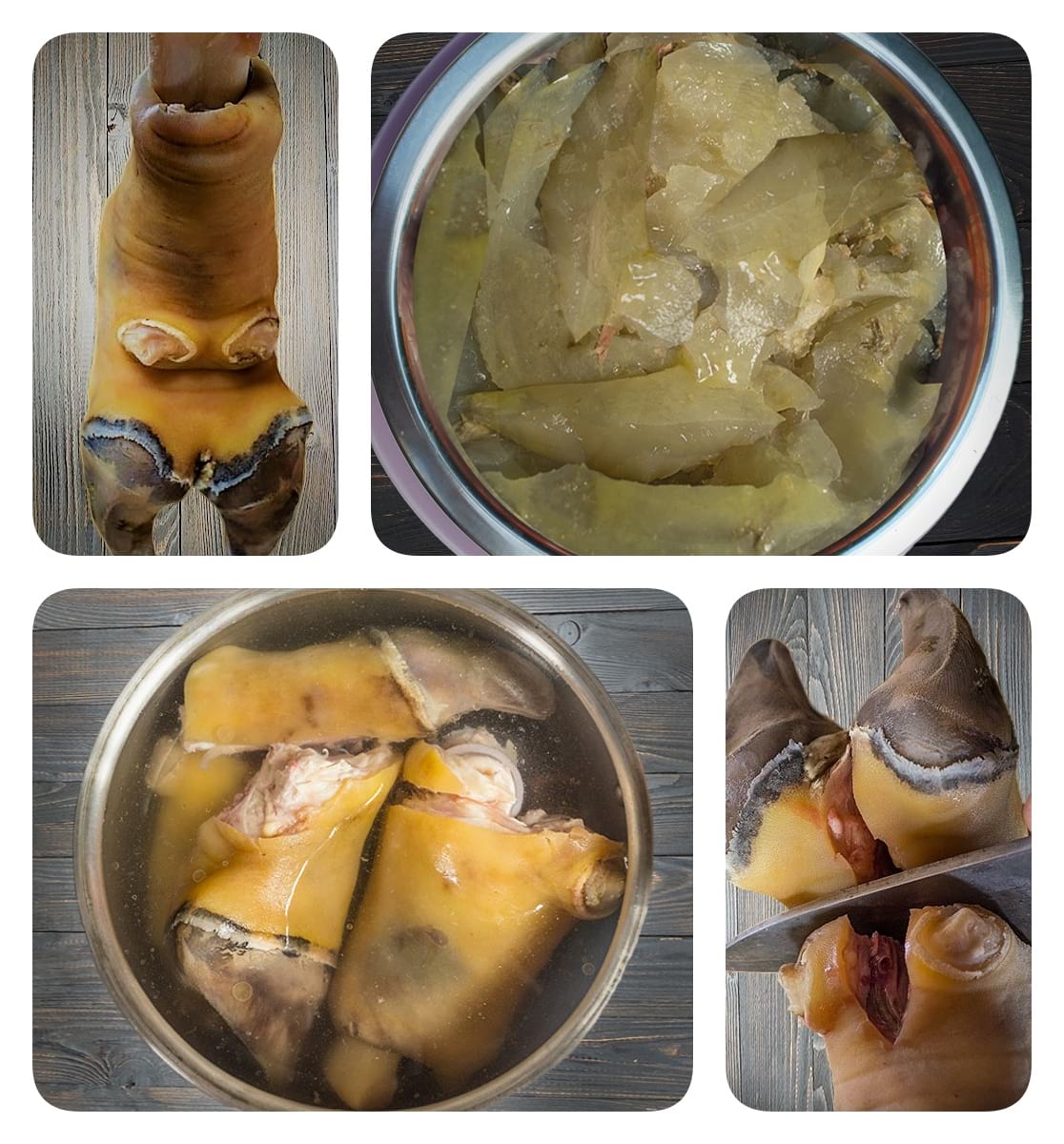Recipe for Making Healthy Treats for Your Pet
Traditional jelly is a popular dish for winter holidays and can be enjoyed year-round. It's not only delicious but also nutritious. Additionally, dog owners must ensure that any jelly served to dogs is safe and suitable for their dietary needs. Homemade, dog-friendly jelly can be a creative and healthy addition to their meals. Just be sure to avoid ingredients that can harm dogs and consult a veterinarian for guidance on the best options.

Jelly
The main question that arises is, "Can dogs eat jelly?"
The Benefits of Jelly for Dogs
You can and should give jelly to dogs! But don't rush to treat your pet with a dish gathered from all the plates. Please don't confuse them! It would be best not to feed your dog jelly from your table. Let's look at jelly's benefits for dogs and how to make it suitable for them.
Jelly contains:
Some of the most essential substances that jelly contains for dogs are collagen and gelatin, which:
It is especially recommended for animals whose diet lacks meat and bone products.
But how should you feed it to them?
It's simple. According to the standard, giving it twice a week is recommended. However, considering the individual characteristics of the animal and the purpose of feeding it jelly, it is considered normal to give it from 1 to 3 times a week.
The Danger Hidden in Jelly
Are there any contraindications for consumption? Of course, like any other product, jelly for dogs is not always beneficial.
Jelly is a high-calorie food that should not be given to dogs suffering from obesity. Excessive consumption negatively affects the liver. Less calorie-rich dishes can be prepared from turkey, beef, and chicken. Stomach upsets or allergies in the form of vomiting, diarrhea, decreased activity, itching, and rashes may occur.
As they say, "Everything in moderation." Any excess product can harm your pet.
We also have a bad habit of feeding them from our table or even cooking as if it's for ourselves.
Important: The products you buy in stores are sold for humans only. It will not benefit your pet, and at best, it won't harm them. If you think that making jelly yourself will significantly help your dog, you are mistaken. Remember: the jelly from your table is for humans.
So, what sets it apart, and how do you make it?
The main question that arises is, "Can dogs eat jelly?"
The Benefits of Jelly for Dogs
You can and should give jelly to dogs! But don't rush to treat your pet with a dish gathered from all the plates. Please don't confuse them! It would be best not to feed your dog jelly from your table. Let's look at jelly's benefits for dogs and how to make it suitable for them.
Jelly contains:
- B-group vitamins
- Microelements: calcium, phosphorus, potassium, fluoride, sulfur, boron, zinc; ascorbic acid
- Retinol
- Glycine
- Polyunsaturated fatty acids
Some of the most essential substances that jelly contains for dogs are collagen and gelatin, which:
- Maintain hemoglobin levels
- Help fight viral diseases
- Improve calcium absorption
- Support normal psychoemotional health and brain function
- Have a positive effect on skin, muscle tissues, ligaments, and joints
- Serve as excellent prevention for arthritis and rickets
It is especially recommended for animals whose diet lacks meat and bone products.
But how should you feed it to them?
It's simple. According to the standard, giving it twice a week is recommended. However, considering the individual characteristics of the animal and the purpose of feeding it jelly, it is considered normal to give it from 1 to 3 times a week.
The Danger Hidden in Jelly
Are there any contraindications for consumption? Of course, like any other product, jelly for dogs is not always beneficial.
Jelly is a high-calorie food that should not be given to dogs suffering from obesity. Excessive consumption negatively affects the liver. Less calorie-rich dishes can be prepared from turkey, beef, and chicken. Stomach upsets or allergies in the form of vomiting, diarrhea, decreased activity, itching, and rashes may occur.
As they say, "Everything in moderation." Any excess product can harm your pet.
We also have a bad habit of feeding them from our table or even cooking as if it's for ourselves.
Important: The products you buy in stores are sold for humans only. It will not benefit your pet, and at best, it won't harm them. If you think that making jelly yourself will significantly help your dog, you are mistaken. Remember: the jelly from your table is for humans.
So, what sets it apart, and how do you make it?
Recipe "Jelly for Dogs"
To make your little one enjoy jelly, select only bone parts from exclusively home-raised cattle or poultry (beef marrow, chicken feet, necks, spine).
Attention!
Everything must be homemade because bones absorb helpful substances, and, as it is no secret, the excessive use of antibiotics on farms is quite common. The greatest danger is not antibiotics in meat but bacteria resistant to them that may be present in it.
Bon appétit for your little one!
To make your little one enjoy jelly, select only bone parts from exclusively home-raised cattle or poultry (beef marrow, chicken feet, necks, spine).
- Select bone parts with as little meat and fat as possible.
- Place the bones in a slow cooker and cover them with water.
- Add 1-2 tablespoons of apple or table vinegar.
- Cook for 20 to 30 hours.
- After cooking, strain the broth and transfer it to a convenient container to cool.
Attention!
Everything must be homemade because bones absorb helpful substances, and, as it is no secret, the excessive use of antibiotics on farms is quite common. The greatest danger is not antibiotics in meat but bacteria resistant to them that may be present in it.
Bon appétit for your little one!

First Aid for Poisoning and Overeating
What do you do if your little one has an upset stomach?
Who and How to Feed?
Puppies need jelly. It contributes to the normal formation and development of the skeletal system. You can gradually increase the portion if your puppy does not show signs of allergies within a day. The norm for a four-month-old puppy of medium-sized breeds is 30-50 grams per day.
It benefits representatives of large breeds: Newfoundland, Caucasian Shepherd, Central Asian Shepherd, Great Dane, Cane Corso, and others. For young large dogs during active growth and weight gain, jelly is also essential to prevent possible deformation of bone tissues and abnormalities in the development of the jaw apparatus.
When your pet's health needs support, old-fashioned jelly comes to your rescue! It is a rich source of collagen and gelatin for dogs, recommended by veterinarians and experienced loving owners.
What do you do if your little one has an upset stomach?
- Do not stop vomiting - the body is clearing itself of toxins or excess food.
- For the first day, give only water. Access to water should be constant - the body will cleanse itself faster.
- Stick to a low-fat diet for a minimum of 7 days. Give absorbent drugs for 5-7 days (for example, Enterosgel - dosage is based on weight).
- Contact a veterinarian to determine the cause of such a reaction to food (in case of poisoning), make an accurate diagnosis, and prescribe the necessary treatment (in case of poisoning).
- Carefully ensure the diet is balanced and your dog does not overeat.
Who and How to Feed?
Puppies need jelly. It contributes to the normal formation and development of the skeletal system. You can gradually increase the portion if your puppy does not show signs of allergies within a day. The norm for a four-month-old puppy of medium-sized breeds is 30-50 grams per day.
It benefits representatives of large breeds: Newfoundland, Caucasian Shepherd, Central Asian Shepherd, Great Dane, Cane Corso, and others. For young large dogs during active growth and weight gain, jelly is also essential to prevent possible deformation of bone tissues and abnormalities in the development of the jaw apparatus.
When your pet's health needs support, old-fashioned jelly comes to your rescue! It is a rich source of collagen and gelatin for dogs, recommended by veterinarians and experienced loving owners.